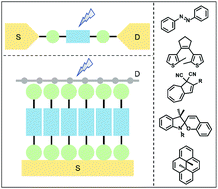Molecular electronic devices with tunable conductance states show great potential in building memories and logic components for next-generation circuits. In recent years, photoswitchable molecular devices have attracted worldwide interest because of the high spatial and temporal resolution, low cost and non-invasibility of light. Herein, an overview of the progress in photoswitching molecular junctions based on single molecules or self-assembled monolayers of photochromic molecules (i.e., azobenzene, diarylethene, dihydroazulene, spiropyran and dihydropyrene) in the recent decade and a brief description of methods to construct photoswitchable molecular devices are provided. An outlook of the future research directions and challenges for this field is also presented.
